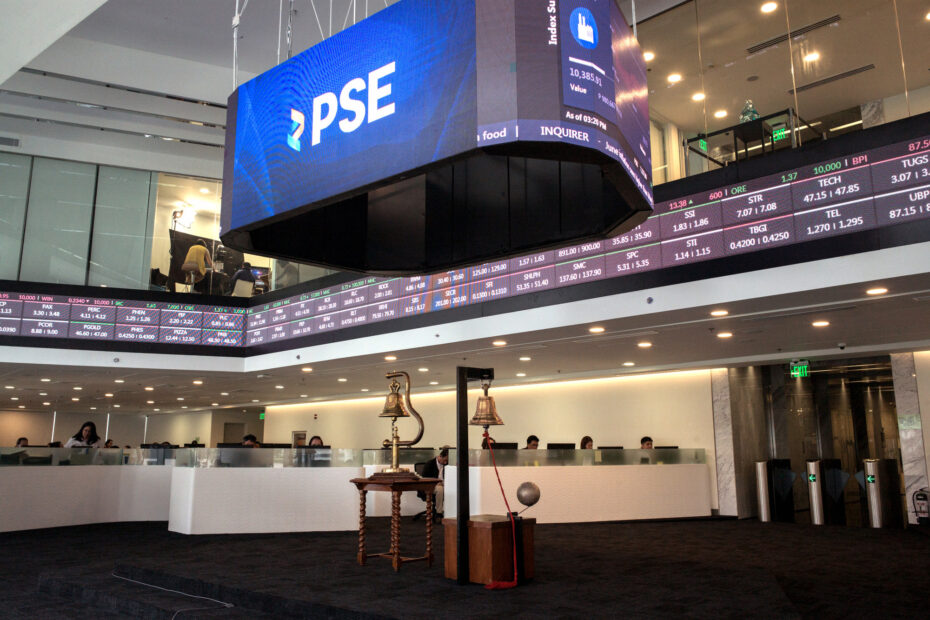THE MARKET SUMMARY
The robust performance of economic indicators provided a buoyant atmosphere for investors throughout the initial quarter of 2024. Notably, the US economy exhibited stronger growth than anticipated in the fourth quarter of 2023, while the composite Purchasing Managers’ Index (PMI) data continued to signal expansion, bolstering investor confidence.
Moreover, positive macroeconomic indicators from various regions worldwide contributed to the notion of a gradual economic slowdown rather than a sharp downturn, supporting market sentiment.
In this context, Philippine stocks demonstrated significant gains, with the PSEi advancing by +7.03% during the first quarter.
Despite a minor month-on-month decline of -0.59%, volatility remained subdued. While investors in equities celebrated favorable economic data, concerns arose from persistently high inflation readings, resilient economic activity, and a nuanced shift in the Federal Reserve’s stance away from its previously dovish December tone. Consequently, sentiment soured, leading to a recalibration of market expectations regarding interest rate cuts.
Forecasts adjusted from an initial estimate of six to seven cuts in 2024, to a more restrained outlook of no more than three, commencing in June. The diminishing likelihood of aggressive rate cuts, now aligned with the Fed’s latest projections, prompted adverse reactions in interest rate-sensitive assets like real estate. Additionally, commodity markets experienced mixed dynamics,
with oil prices rising due to ongoing supply constraints and geopolitical tensions, while gas prices declined.
Despite these fluctuations, investors enjoyed a positive start to the year, albeit with a notable concentration of gains in large-cap growth stocks against a backdrop of expanding market valuations. However, the increasingly nuanced market environment suggests a waning appetite for perfection, potentially inviting profit-taking activities.
While the resilience of the global economy and anticipated rate adjustments in the latter part of the year may sustain positive momentum, market conditions appear less impervious to volatility, given the multitude of economic, environmental, political, and geopolitical risks. Hence, maintaining a well-diversified portfolio is paramount, offering investors ample opportunities to bolster resilience.
Fixed income markets, now more reasonably priced compared to the previous year’s end, could serve as a buffer against adverse growth shocks. Furthermore, stocks with attractive dividend and share buyback yields may enhance portfolio resilience in the equity market.
THE STORIES THAT SHAPED THE MARKET
February Inflation
Headline accelerated for the first time in five months in February as prices of food, particularly rice, rose faster than expected, according to preliminary data from the Philippine Statistics Authority (PSA).
Data released by the PSA showed that the consumer price index (CPI) quickened to 3.4% in February from 2.8% in January but slower than the 8.6% print a year ago.
The February print was above the 3% median estimate in a poll.
However, it settled within the central bank’s 2.8-3.6% forecast for the month and marked the third straight month that inflation was within the 2-4%target range.
Month on month, inflation quickened by 0.6%. Stripping out seasonality factors, month-on-month inflation rose by 0.9%. For the first two months of 2024, headline inflation averaged 3.1%. This was lower than the central bank’s 3.6% full-year baseline forecast.
This inflation outturn is consistent with central bank expectations that inflation will likely remain within the target range in the first quarter of 2024 due largely to negative base effects, the central bank said in a statement.
However, inflation could temporarily accelerate above the target range in the second quarter of 2024 due to the adverse impact of El Niño weather conditions on agricultural production and positive base effects, it added.
Core inflation, which excludes volatile prices of food and fuel, rose by 3.6% in February year on year. This was slower than 3.8% in the previous month and 7.8% a year ago.
National Statistician Claire Dennis S. Mapa said February inflation was mainly driven by the faster annual increase in the heavily weighted index for food and nonalcoholic beverages.
The index accelerated to 4.6% in February from 3.5% in the previous month but was slower than the 10.8% clip a year earlier.
Food inflation alone quickened to 4.8% from 3.3% in January, mainly driven by rice. However, this was slower than the 11.1%logged in 2023.
Rice inflation surged to 23.7% in February from 22.6% in January and 2.2% in the same month a year ago. It also marked the fastest print for rice inflation since the 24.6%recorded in February 2009.
Prices of regular milled, well-milled, and special rice also saw faster price increases on a year-on-year and month-on-month basis, according to the agency.
The average price of a kilogram of regular milled rice rose to P50.44 in February from P49.65 in the previous month and P39.65 a year earlier; well-milled rice increased to P55.93 from P54.91 a month ago and P43.99 in the previous year; and special rice averaged P64.42 from P63.9 in January and P53.89 a year ago.
Mr. Mapa said rice inflation continued to quicken due to tight supply and continued high prices in the world market as well as base effects.
Rice prices may continue to spike in the coming months.
While lower tariff rates, an increase in rice imports, and the harvest season should help cap the continued rise in prices, they are expected to remain elevated as export restrictions remain from India, the world’s biggest supplier, and as importing countries increase purchases to combat the effects of El Niño, which could last until midyear.
The acceleration of food inflation was also overall driven by the cereals and cereal products index, which jumped to 17% from 16.3%in the previous month and 5.2% a year ago.
Meanwhile, inflation of vegetables, tubers, plantains, cooking bananas, and pulses saw an 11.1% decline during the month from the 20.8%drop in the previous month. In 2023, the index accelerated by 33.1%.
The index for meat and other parts of slaughtered land animals inched up to 0.7%, slower than the 6.5% print a year ago. PSA data showed that transport inflation also contributed to the uptrend in February inflation.
Transport inflation rose to 1.2% during the month from the 0.3% decline in January but was much slower than the 9% print in the year prior.
Mr. Mapa said this was driven by an uptick in the operation of personal transport equipment, which includes fuel and toll facilities, as well as passenger transport services and the purchase of vehicles, namely motorcycles.
In February alone, pump price adjustments stood at a net increase of P1.05 a liter for gasoline, P1.55 a liter for diesel and P0.35 a liter for kerosene.
Inflation for housing, water, electricity, gas and other fuels also rose to 0.9% in February from 0.7% a month earlier but was slower than the 8.6% a year ago.
Manila Electric Co. (Meralco) earlier said that the overall rate for a typical household rose by P0.5738 to P11.9168 per kilowatt-hour (kWh) in February from P11.3430 in the previous month.
The increase in the cost of utilities and transport has been marginal as global oil prices have remained stable in recent months.
Meanwhile, the inflation rate for the bottom 30% of income households rose to 4.2% in February from P3.6% in the previous month. However, this was slower than the 9.7% a year ago.
In the first two months, the inflation rate averaged 3.9% for the bottom 30%. In the National Capital Region (NCR), inflation quickened to 3.2% in February from 2.8% in January. Inflation in areas outside NCR accelerated to 3.5%from 2.8%. With the uptick in February inflation, the central bank said it sees the need to keep policy settings steady in the near term.
Looking ahead, the Monetary Board deems it appropriate to keep the central bank’s monetary policy settings unchanged in the near term amid the improvement in inflation conditions. The central bank has kept its benchmark rate steady at a near 17-year high of 6.5% in February for a third straight meeting.
The central bank has raised borrowing costs by 450 basis points (bps) from May 2022 to October 2023. Central Bank Governor Eli M. Remolona, Jr. earlier said that any policy easing moves in the first semester may be too soon.
The acceleration in February inflation affirms the central bank’s hawkish stance in the past months.
While inflation has gone down recently, there are lingering risks on the upside. Maintaining a hawkish tone is crucial in order to temper inflation expectations and prevent a cycle of rising prices, especially considering ongoing supply issues affecting rice.
The central bank may keep rates steady for the first half before possibly cutting rates by the second semester once inflation is firmly within target.
February inflation will likely prompt the central bank to extend its pause.
Mr. Remolona has been telegraphing an eventual rate cut towards the latter half of the year, likely waiting for inflation to show convincing signs of staying well within target. If inflation manages to stay relatively subdued and the Fed finally starts to ease, the central bank is expected to likewise
begin its easing cycle to give economic growth added support in the face of challenging global headwinds.
If inflation quickens or risks to inflation materialize in the second quarter there is a risk that the central bank will instead cut after the Fed, keeping the central bank rate at 6.5%for a longer period than expected.
DoF Proposes Key Changes to Mining Fiscal Reform Bill The Finance Department is proposing a simplified fiscal regime for the Philippine mining industry that is seen to generate as much as P10 billion in additional revenues every year.
In a statement, the Department of Finance (DoF) said it is pushing for the Rationalization of the Mining Fiscal Regime, which aims to simplify the tax system, ensure the government’s fair share in mining revenues, and establish good governance in the mining industry.
The DoF said its proposal is simpler than House Bill (HB) No. 8937 as it adopts fewer tiers and rates for easier compliance and implementation. The House of Representatives approved HB 8937 on third and final reading in September 2023.
Under the DoF’s new proposal, large-scale metallic mining operations inside mineral reservations will still pay the government 5% of their gross output. This is higher than the 4% under the House bill.
Margin-based royalties on income from metallic operations will be imposed on those outside mineral reservation areas.
The DoF is proposing a margin-based royalty rate of 1.5-5% with only four tiers, unlike the House version that proposes 1-5% with eight tiers. For instance, miners with margins of 1% but not over 20% would be subject to a 1.5% rate.
Compared to the eight-tier structure from HB 8937, the four-tier makes it simpler for investors and the Bureau of Internal Revenue (BIR) to compute the corresponding tax rates. Furthermore, the simplified DoF version will lessen incentives for the private sector to pursue aggressive accounting to avoid taxes, the DoF said.
The DoF is also proposing to simplify the windfall profit tax to just four tiers, from 10 tiers under the House bill. For example, miners with margins of 26% but not more than 45% will be subject to 1.5%, while those with margins of more than 75% will be imposed a 10% rate.
Similarly, a four-tier, compared to the 10-tier structure in HB 8937, margin-based windfall profits tax rate ranging from 1.5% to 10% on income from mining operations is proposed in light of the sudden increases in the world prices of metal, the DoF said.
Based on its new proposal, the DoF expects the compromise mining fiscal regime to generate an average of P10.23 billion a year from 2025 to 2028.
Broken down, the government expects to generate an annual average of P5.55 billion from royalty tax on miners inside mineral reservations, P1.31 billion from royalty tax on miners outside mineral reservations, and P3.37 billion from the windfall profit tax.
Mining companies in the country currently pay corporate income tax, excise tax, royalty, local business tax, real property tax, and fees to indigenous communities.
The Rationalization of the Mining Fiscal Regime is part of the Legislative-Executive Development Advisory Council’s (LEDAC) list of 20 priority measures and is one of President Ferdinand R. Marcos, Jr.’s priority bills.
Chamber of Mines of the Philippines (CoMP) Chairman Michael T. Toledo said the proposed four-tier royalty rate will result in an increase in the annual effective tax rate to 60.6% from the 59.6% under HB 8937. This would be higher than those in Indonesia, Chile, Peru, South Africa, and Canada.
The CoMP also proposes a four-tier regime, but one that starts at 1%. Mr. Toledo said this would make it easier for the BIR to implement without affecting the country’s competitiveness as a mining investment destination.
Red Sea Crisis Could Fan Asia’s Inflation Anew, Delay Rate Cuts
Asia could see slower economic growth and a resurgence of inflation as escalating violence in the Red Sea snarls shipping between the region and their trade partners in the US and Europe, according to the Economist Intelligence Unit.
The supply chain disruptions could cut as much as 0.5 percentage points off Asia’s economic growth this year and add up to 0.4 percentage points to the inflation rate, the EIU said in a report.
Given that Asian exports were already hit last year by weak Western demand, the recent attacks will weigh further on various export-dependent economies, particularly in Southeast Asia, where container trade has nearly collapsed, the report read, citing Indonesia, Thailand and Malaysia as among those most vulnerable.
Most of the region will likewise be hit indirectly through the spike in shipping costs, especially those that rely on food imports such as the pacific island countries, New Zealand, India and Pakistan.
Higher inflation could leave central banks in countries such as the Philippines, Australia and India in a more difficult situation in terms of finding an opportunity to begin monetary easing, the EIU said.
Protracted shipping disruptions could also push manufacturers to seek options closer to their end-user markets, rather than tapping the stretched supply chains in Asia, it said.
Based on EIU estimates, shipments from northwest Europe now take 56 days to reach Malaysia and Singapore from 32 days before the Houthi attacks began in November. For China, Hong Kong and Taiwan, it lengthened to 55 days from 42 days.
Resilient demand has allowed global shipments to pull off an unlikely rebound in the face of continuing supply chain disruptions.
Only two out of 10 indicators in the trade dashboard were in “below normal” territory in March, its best reading since at least end-2022. The improvement was driven by a healthy export performance out of trade bellwether Taiwan, buoyed by stronger demand for electronics. The outlook likewise brightened among US firms as new export orders expanded for the first time in 19 months.
Shipping volumes in the major ports of LA and Hong Kong even climbed to above normal territory in the latest readings, despite escalating violence in the Red Sea that’s keeping logistics costs elevated.
Europe, however, remains a laggard. While global manufacturing finally ramped up in February, data showed output for the euro area and the UK remained in contraction territory. German firms remained deeply pessimistic.
The green shoots of recovery are a welcome sign amid warnings from the World Trade Organization that global commerce may come in weaker than expected this year, hampered by the choke points in vital shipping arteries. Sticky inflation in developed markets has also kept the much-anticipated lowering of interest rates at bay.
Inflation Uptick May Delay Rate Cuts
A potential uptick in inflation over the next few months could prompt the central bank to delay its rate-easing cycle.
Central bank Governor Eli M. Remolona, Jr. last week said that inflation could have quickened further to 3.9%in March.
Inflation accelerated to 3.4% in February, the first time it quickened in five months. If the headline print picks up in March, this would mark the second straight month that inflation accelerated.
Inflation data for March is scheduled to be released on April 5.
The central bank earlier said that inflation could temporarily accelerate above the 2-4% target range in the second quarter due to the El Niño dry spell and positive base effects.
The uptrend in inflation will delay the decision to cut rates since inflation is the key variable that the central bank is monitoring to guide its decision regarding policy rates.
The Monetary Board kept its benchmark rate steady at a near 17-year high of 6.5% for a third straight meeting in February. From May 2022 to October 2023, the central bank has raised borrowing costs by 450 basis points (bps).
The Monetary Board moved its policy meeting, originally scheduled for April 4, to April 8, citing the timing of key data releases such as March inflation.
Finance Secretary Ralph G. Recto said that while inflation may remain elevated in the coming months, it will eventually return to within the 2-4%target. Mr. Recto said he expects March inflation to settle at around 3.9%, similar to Mr. Remolona’s estimate.
This year, the central bank expects inflation to average 3.6%.
The central bank is seen to begin slashing rates in sync with the US Federal Reserve, which is widely expected to start its easing cycle by June.
The FOMC (Federal Open Market Committee) stood pat at its meeting, keeping its fed funds steady at the 5.25-5.5% range. From March 2022 to July 2023, the Fed increased rates by a total of 525 bps.
Mr. Remolona earlier said that while the Monetary Board closely monitors the Fed, its own policy decisions are not dependent on the US central bank. He also said the BSP will likely begin cutting “in the next few policy meetings.
While it will be economically advantageous for the country to mirror the Fed in terms of easing, there is leeway for the country to make decisions on rate cuts ahead of the Fed depending on marginal changes in the inflation rate.
If the Fed cuts rates as expected in June, the central bank will likely begin rate cuts around the same time or in the second half of 2024. However, if the Fed delays its first rate cut, this could also affect the central bank’s own policy easing.
CREIT / SM
Citicore Renewable Energy Corp. (CREC) said it raised P5 billion after selling its shares in its real estate investment trust to conglomerate SM Investments Corp. (SMIC).
The energy company sold a total of 1.88 billion common shares, equivalent to 28.79% in Citicore Energy REIT Corp. (CREIT) at P2.6534 per share, the Saavedra-led company said in a statement.
The transaction was carried out with CREC’s subsidiary Citicore Solar Tarlac 1, Inc.
CREC said it will continue to be the single largest stakeholder in CREIT with a 32.88% effective ownership post-transaction.
Proceeds from the sale will contribute to the development of CREC’s ready-to-build and under-construction solar power projects with a total capacity of 1,583 megawatts, the company said.
BDO Capital & Investment Corp. acted as transaction adviser for the sale.
In a separate disclosure, SMIC said it does not see any material impact on its financials or operations. This deal shows SM’s commitment to expanding in the renewable energy space. Nonetheless, it is also a bet on real estate since CREIT is the country’s largest renewable energy REIT landlord.
The deal is a win-win for the conglomerate since it is supporting the renewable energy sector in a way that is still within its core property business.
CREC is targeting to go public by the second quarter, aiming to raise as much as P12.9 billion.
It was supposed to conduct its initial public offering in March. The company is set to offer 2.9 billion common shares at a maximum price of P3.88 apiece, including an additional 435 million outstanding common shares for overallotment.
This Market Recap is provided by Globalinks Securities and Stocks Inc.



